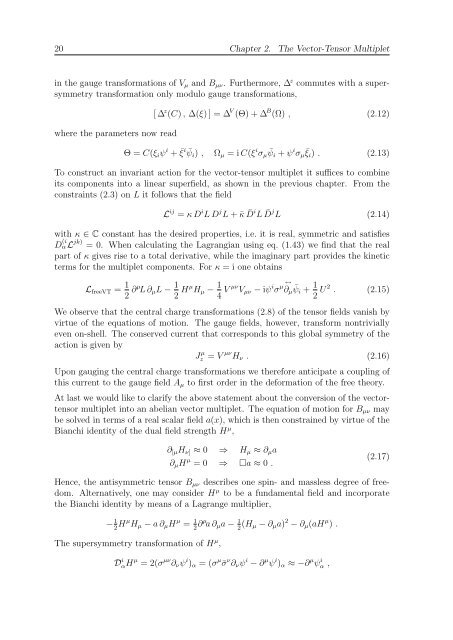N=2 Supersymmetric Gauge Theories with Nonpolynomial Interactions
N=2 Supersymmetric Gauge Theories with Nonpolynomial Interactions
N=2 Supersymmetric Gauge Theories with Nonpolynomial Interactions
You also want an ePaper? Increase the reach of your titles
YUMPU automatically turns print PDFs into web optimized ePapers that Google loves.
20 Chapter 2. The Vector-Tensor Multiplet<br />
in the gauge transformations of Vµ and Bµν. Furthermore, ∆ z commutes <strong>with</strong> a supersymmetry<br />
transformation only modulo gauge transformations,<br />
where the parameters now read<br />
[ ∆ z (C) , ∆(ξ) ] = ∆ V (Θ) + ∆ B (Ω) , (2.12)<br />
Θ = C(ξiψ i + ¯ ξ i ¯ ψi) , Ωµ = i C(ξ i σµ ¯ ψi + ψ i σµ ¯ ξi) . (2.13)<br />
To construct an invariant action for the vector-tensor multiplet it suffices to combine<br />
its components into a linear superfield, as shown in the previous chapter. From the<br />
constraints (2.3) on L it follows that the field<br />
L ij = κ D i L D j L + ¯κ ¯ D i L ¯ D j L (2.14)<br />
<strong>with</strong> κ ∈ C constant has the desired properties, i.e. it is real, symmetric and satisfies<br />
D (i<br />
α L jk) = 0. When calculating the Lagrangian using eq. (1.43) we find that the real<br />
part of κ gives rise to a total derivative, while the imaginary part provides the kinetic<br />
terms for the multiplet components. For κ = i one obtains<br />
LfreeVT = 1<br />
2 ∂µ L ∂µL − 1<br />
2 Hµ Hµ − 1<br />
4 V µν Vµν − iψ i ↔<br />
µ<br />
σ ∂µ ¯ ψi + 1<br />
2 U 2 . (2.15)<br />
We observe that the central charge transformations (2.8) of the tensor fields vanish by<br />
virtue of the equations of motion. The gauge fields, however, transform nontrivially<br />
even on-shell. The conserved current that corresponds to this global symmetry of the<br />
action is given by<br />
J µ z = V µν Hν . (2.16)<br />
Upon gauging the central charge transformations we therefore anticipate a coupling of<br />
this current to the gauge field Aµ to first order in the deformation of the free theory.<br />
At last we would like to clarify the above statement about the conversion of the vectortensor<br />
multiplet into an abelian vector multiplet. The equation of motion for Bµν may<br />
be solved in terms of a real scalar field a(x), which is then constrained by virtue of the<br />
Bianchi identity of the dual field strength H µ ,<br />
∂[µHν] ≈ 0 ⇒ Hµ ≈ ∂µa<br />
∂µH µ = 0 ⇒ a ≈ 0 .<br />
(2.17)<br />
Hence, the antisymmetric tensor Bµν describes one spin- and massless degree of freedom.<br />
Alternatively, one may consider H µ to be a fundamental field and incorporate<br />
the Bianchi identity by means of a Lagrange multiplier,<br />
− 1<br />
2 Hµ Hµ − a ∂µH µ = 1<br />
2 ∂µ a ∂µa − 1<br />
2 (Hµ − ∂µa) 2 − ∂µ(aH µ ) .<br />
The supersymmetry transformation of H µ ,<br />
D i αH µ = 2(σ µν ∂νψ i )α = (σ µ ¯σ ν ∂νψ i − ∂ µ ψ i )α ≈ −∂ µ ψ i α ,

















